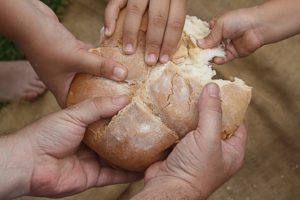 The title of this blog post might sound irreverent, but I do not intend it that way. I use titles to attract attention—some people thought my book How to Get to Heaven Without Going to Church was antichurch, but that book was really about the power of Jesus.
The title of this blog post might sound irreverent, but I do not intend it that way. I use titles to attract attention—some people thought my book How to Get to Heaven Without Going to Church was antichurch, but that book was really about the power of Jesus.
In a previous blog post entitled “Eating Jesus,” I discussed the Eucharist and its many interpretations. Some people view the bread and wine as reminders of Jesus while others think an unbelievable chemical reaction transforms these elements into the actual flesh and blood of Jesus. (Personally, I think eating and drinking human flesh and blood is barbaric.)
The other day, as I read an article about Communion, I had a new idea about the deeper meaning of the “body and blood” of Jesus.
First, I’ll lay the groundwork by rejecting Paul’s idea of Jesus being the “sacrificial lamb” who died for our sins, which is silly. In reality, Jesus was executed because he was a nuisance to some members of the Jewish hierarchy, and they wanted him out of the way. Rome cooperated. That kind of arrangement occurs frequently. (Look at what happened to journalist Jamal Khashoggi in Saudi Arabia.)
Here is what I think the phrase “This is my body, which is given for you,” really means. Jesus died (no swooning) at Golgotha. However, his Followers are alive to this day, so we must use our living bodies to be Jesus’s arms and legs and minister to the “least of these” (Matthew 25:40). Every time I take the “body” at Communion, I am reminded that my body needs to tutor prisoners in jail and the children of refugees. This body must find solutions to homelessness; stamp out poverty; feed the hungry; serve in hospitals, schools, and assisted living facilities; and accept all human beings, no matter where they are on their life journey.
I like this idea: Jesus’s body may be dead, but my living body can still carry out his ministry. A symbolic wafer, piece of bread, pretzel, or even cookie can serve as a reminder that I am the arms and legs of Jesus.
(Many years ago, when I worked in Hawai’i, a group of clergypeople preparing to demonstrate against the war in Vietnam wanted to take Communion. All we had on hand were cold coffee and a couple of cookies, but they worked!)
The next part of the Communion rite says, “This is my blood that is shed for you. Drink this in remembrance of me.” Whether the actual beverage served at Mass is wine (red or white, sweet or dry), juice, water, or coffee, the “blood” symbolizes the spiritual lifeblood that Jesus passed on to his Followers. Some call this the Holy Spirit or the power of agape or maybe even presence.
This lifeblood directs how I live. I know that I have to demonstrate agape and accept everyone (no exceptions), that I must constantly forgive myself and others, and that caring for others must be a top priority in my life.
I like this idea because it transforms Communion into a call to action.
What do you think about this new interpretation of the Eucharist?
Image is in the public domain courtesy of Gustavo Di Nucci
This is the best explanation for the Eucharist I have read. It gives a real meaning to a silly belief. Maybe I will go back to church!
Gracias por elegir esa foto que amo entrañablemente… El día que la pensé y la hice buscaba dar una idea sobre el “Dar Pan” ese alimento que debió ser más que un descubrimiento, todo un invento, que se fue propagando en todas las razas y culturas de la humanidad y se fue trasmitiendo de generación en generación… por eso elegí las manos de mis hijos y mis nietos para hacerla.
Jesús no se equivoco al tipificar al pan con su cuerpo, que mas allá de la forma que alguien quiera celebrarla en una Eucaristía o Santa Cena… El cuerpo de Cristo no se parte… se comparte (“lo partió y dio a sus discípulos” – Mat. 26:26) y mas allá de la interpretación “mágica” o de simple memorial de su sacrificio… realmente participamos de su cuerpo cuando nosotros nos trasnformamos en ese pan, en nuestros actos diarios por la fe en lo que nos enseño Jesús, No por nada el autor del Libro de Romanos expresa: “…os ruego por las misericordias de Dios que presentéis vuestros cuerpos como sacrificio vivo y santo, aceptable a Dios” Rom 12:1
La Eucaristia o Santa Cena verdaderamente comienza cuando nos partimos y nos damos en amor
Un fuerte abrazo!
Thank you Gustavo for reading my blogs and especially for sharing my thoughts with the folks in Majorca.
PeaceLoveJoyHope
Bil